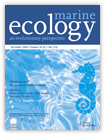Physiology of Laminaria
III. Effect of a Coastal Eutrophication Gradient on Seasonal Patterns of Growth and Tissue Composition in L digitata LAMOUR. and L. saccharina (L) LAMOUR.
Abstract
Abstract. Dissolved nitrate, nitrite, ammonium and phosphate were monitored for 2.5 years along a coastal eutrophication gradient originating at the St. Andrews sewer outfall. Linear growth rates and tissue composition (phosphorus, various nitrogen fractions and storage carbohydrates) were monitored at the same stations in lamina tissue of Laminaria digitata and L. saccharina. Growth rates were considerably enhanced at the eutrophicated stations both in spring, when exogenous nutrients were at peak values at all stations, and during the summer when exogenous nutrients were very low at all stations. Enhanced summer growth rates were correlated with the increased reserves of N and P accumulated during winter and spring, and particularly with soluble organic nitrogen reserves. Accumulation of storage carbohydrates was inversely correlated with growth rate and tissue N and P reserves, presumably because fixed carbon could be incorporated into new protein and thence new tissue only if internal non-protein N reserves were available.




